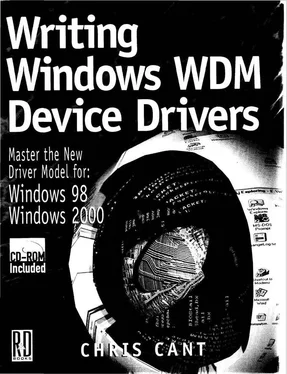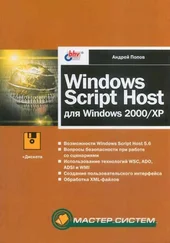Chris Cant - Writing Windows WDM Device Drivers
Здесь есть возможность читать онлайн «Chris Cant - Writing Windows WDM Device Drivers» весь текст электронной книги совершенно бесплатно (целиком полную версию без сокращений). В некоторых случаях можно слушать аудио, скачать через торрент в формате fb2 и присутствует краткое содержание. Город: Lawrence, Kansas 66046, ISBN: , Издательство: R & D Books, Жанр: Программирование, на английском языке. Описание произведения, (предисловие) а так же отзывы посетителей доступны на портале библиотеки ЛибКат.
- Название:Writing Windows WDM Device Drivers
- Автор:
- Издательство:R & D Books
- Жанр:
- Год:неизвестен
- Город:Lawrence, Kansas 66046
- ISBN:0-87930-565-7
- Рейтинг книги:5 / 5. Голосов: 1
-
Избранное:Добавить в избранное
- Отзывы:
-
Ваша оценка:
- 100
- 1
- 2
- 3
- 4
- 5
Writing Windows WDM Device Drivers: краткое содержание, описание и аннотация
Предлагаем к чтению аннотацию, описание, краткое содержание или предисловие (зависит от того, что написал сам автор книги «Writing Windows WDM Device Drivers»). Если вы не нашли необходимую информацию о книге — напишите в комментариях, мы постараемся отыскать её.
Writing Windows WDM Device Drivers — читать онлайн бесплатно полную книгу (весь текст) целиком
Ниже представлен текст книги, разбитый по страницам. Система сохранения места последней прочитанной страницы, позволяет с удобством читать онлайн бесплатно книгу «Writing Windows WDM Device Drivers», без необходимости каждый раз заново искать на чём Вы остановились. Поставьте закладку, и сможете в любой момент перейти на страницу, на которой закончили чтение.
Интервал:
Закладка:
| Hardware DMA | System function (default) |
|---|---|
| DMA 0 | ISA expansion |
| DMA 1 | |
| DMA 2 | FDC |
| DMA 3 | extended capabilities port (ECP) parallel port on LPT 1 |
| DMA 4 | DMA controller cascading |
| DMA 5 | |
| DMA 6 | |
| DMA 7 |
Over the years, various hardware developments have seen the light of day, such as MCA, EISA, PCI, and SCSI buses, with Plug and Play capability. Not all these developments have won market support.
PC 99 still supports all these "legacy" peripherals, if they are present in the system.
PCs have a Basic I/O System (BIOS) in ROM that runs when the computer is first switched on. This ROM finds the relevant operating system and runs its boot loader to start DOS, Windows 98, Windows 2000, or whatever.
Changing World
Most programs that are used nowadays run using Win32 (or at least Win16) functions. These routines do not allow direct access to I/O ports, etc. For example, when keyboard input is required, W98 or W2000 carries out the necessary operation. In the IBM-compatible environment, it interacts with the keyboard controller using techniques dating from time immemorial.
Less DOS applications are being run. In W98, NT, and W2000, these do not get direct access to the hardware. Instead, a Virtual Device Driver arbitrates access to these peripherals, allowing multiple DOS and Windows applications to run at the same time.
These two developments allow the Windows operating systems to move away from the original IBM-compatible specification. As long as the right keystroke messages get through to user programs, it does not matter where in hardware they come from. For old DOS programs that do try to access the actual hardware, virtual device drivers on faster new machines can emulate the required functionality.
The new wisdom is that the USB and IEEE 1394 (originally called FireWire) devices represent an easier way for users to connect assorted peripherals to the system, including standard system components such as a keyboard and a mouse. The idea is that any devices can be plugged in easily (even when the computer is on) and — within limits — daisy chained together. USB and IEEE 1394 devices cope with being plugged in anywhere. The Windows Plug and Play system sorts out any resource allocations on the fly.
Whether users will take to the new doctrine remains to be seen. Plugging a new USB device in will certainly be easier than dismantling a case, fiddling with jumpers, and inserting a card. The new Device Bay specification will allow easy insertion of cards within the chassis of the PC.
USB's 12Mbs is designed for slower-speed devices, such as keyboards, mice, joysticks, printers, modems, telephones, and monitors. IEEE 1394 runs faster, at 100 Mbs or more, and is more useful for devices such as scanners, storage units, and audio/visual kit, such as digital cameras.
ACPI, OnNow, and Plug and Play
New PCs aim to use less power and switch on more quickly, as well as supporting Plug and Play. Windows and new BIOS chips use the Advanced Configuration and Power Interface (ACPI) specification to help with these tasks.
ACPI-based hardware knows how to turn off or reduce power to some devices. Windows drivers can now help in this process by using the Power Management IRPs and routines, and the power management routines that are relevant for its device class. The aim of the OnNow initiative is that a PC may appear to be off, when in fact it is just "sleeping", waiting for a soft power on button to be pressed. As the operating system and drivers are already loaded into memory, it takes less time to start up the system. Devices simply need to be powered up for the user to get started. A remote control handset or incoming modem call may similarly be used to wake the system up.
Both Windows 98 and Windows 2000 can now take full use of the Plug and Play hardware facilities to allow easy device insertion and removal. Again, drivers need to help in this process, allocating and releasing resources only as instructed by the Plug and Play Manager.
PC 99 specifies that ACPI, OnNow, and Plug and Play must be supported.:
PC 99 Conformance
Microsoft can certify your hardware and software as PC 99 compatible. To do this, contact their Windows Hardware Quality Labs at http://www.microsoft.com/hwtest/ or e-mail to whqlinfo@microsoft.com. When your driver passes these tests, Microsoft gives you a digital signature catalog file that you should include in your driver's INF file.
The Windows DDK includes a simplified version of Microsoft's own tests on their Hardware Compatibility Tests (HCT) CDs. Check out your driver with these tests before submitting your driver for full testing.
Appendix C
Direct Memory Access
This book does not cover Direct Memory Access (DMA) in detail. However, NT 3.51 and NT 4 driver writers will find that they must access the DMA system routines in a new way. All the same routines are there, you just have to call IoGetDmaAdapter first. This returns a pointer to a DMA_ADAPTER object. The DmaOperations field in there contains pointers to all the familiar routines. Call the DmaOperations PutDmaAdapter callback when you have finished with the DMA_ADAPTER object.
Table C.1 shows the corresponding old and new routines. Just to reiterate, there is no kernel routine directly called PutDmaAdapter . This routine is only available through the DMA_ADAPTER structure, e.g.,
(*DmaAdapter->DmaOperations->PutDmaAdapter)(DmaAdapter);
Table C.1 Old and new DMA routines
| Old | New | New DmaOperations routine | Description |
|---|---|---|---|
HalGetAdapter |
IoGetDmaAdapter |
||
PutDmaAdapter |
Release DmaAdapter |
||
HalAllocateCommonBuffer |
AllocateCommonBuffer |
||
HalFreeCommonBuffer |
FreeCommonBuffer |
||
IoAllocateAdapterChannel |
AllocateAdapterChannel |
||
IoFlushAdapterBuffers |
FlushAdapterBuffers |
||
IoFreeAdapterChannel |
FreeAdapterChannel |
||
IoFreeMapRegisters |
FreeMapRegisters |
||
IoMapTransfer |
MapTransfer |
||
HalGetDmaAlignmentRequirement |
GetDmaAlignment |
Get alignment requirements for DMA buffers | |
HalReadDmaCounter |
ReadDmaCounter |
Get number of bytes remaining to be transferred | |
GetScatterGatherList |
|||
PutScatterGatherList |
Glossary
Acronyms and Tools
\DosDevices |
\?? |
Different names for the symbolic link directory seen by WinObj |
| AC | Alternating Current | |
| ACK | Acknowledge | |
ACK |
USB Acknowledge packet | |
| ACPI | Advanced Configuration and Power Interface | BIOS specification http://www.teleport.com/~acpi/ |
| AGP | Accelerated Graphics Port | |
| APC | Asynchronous Procedure Call | Code that operates in the context of a specific user thread |
| API | Application Programmer Interface | |
| AML | ACPI Machine Language | |
| ASL | ACPI Source Language | |
| ATVEF | Advanced Television Enhancement Forum | HTML-based enhanced television info@atvef.com or, in Europe, dvbinfo@atvef.com |
| BIOS | Basic Input/Output System | |
| BSOD | Blue screen of death | NT and W2000 bugcheck screen |
| build | Command line tool for building drivers | |
| Bulk | A USB data transfer type, for large blocks of data | |
| CDB | Command Descriptor Block | For SCSI commands |
| checked build | Nonoptimized debug build of a driver or Windows, with debug symbols | |
| CIM | Common Information Model | WBEM model for WMI |
| CIMOM | CIM Object Manager | |
| CMIP | Common Management Information Protocol | |
| COM | Common Object Model | |
| Composite device | A USB device with more than one interface | |
| Compound device | A piece of USB hardware with several internal USB devices | |
| Configuration | A set of interfaces in a USB device | |
| Control | A USB data transfer type for small blocks of data | |
DATA0, DATA1 |
USB Data packet IDs | |
| DC | Direct Current | |
| DDC | Display Data Channel | Monitor/video channel enumeration |
| DDK | Driver Development Kit | |
| DDI | Device Driver Interface | |
| DebugPrint | PHD driver trace tool | |
| default pipe | A flow of data to USB Endpoint 0 | |
| DIP | Dual In-line Package | |
| DIRQL | Device Interrupt Request Level | |
| DLL | Dynamic Link Library | |
| DMA | Direct Memory Access | |
| DMI | Desktop Management Interface | |
| DPC | Deferred Procedure Call | Runs at DISPATCH_LEVEL |
| ECP | Enhanced Centronics Port | IEEE P1284 (ECP) |
| endpoint | USB logical connection point | |
| Endpoint 0 | A control endpoint that is present in all USB devices | |
| EPP | Enhanced Parallel Port | |
| FDO | Functional Device Object | |
| frame | A USB frame is the data sent in a 1ms interval | |
| free build | Optimized release retail build of a driver or Windows | |
| GDI | Graphics Device Interface | |
| GMT | Greenwich Mean Time | Kernel system time is measured in 100ns units since January 1, 1601 in the GMT time zone. |
| GUID | Globally Unique Identifier | |
| guidgen | GUID generator tool | |
| HAL | Hardware Abstraction Layer | |
| HBA | Host Bus Adaptor | |
| HCT | Hardware Compatibility Tests | |
HKLM |
HKEY_LOCAL_MACHINE |
|
| HKR | Relative registry key | Used in installation INF files. See Chapter 11 for more details. |
| HID | Human Input Device | |
| HMMP | HyperMedia Management Protocol | |
| hub | A USB device that has downstream ports to let further USB devices be plugged in | |
| IDE | Integrated Development Environment | |
| IEEE 1394 | A high speed serial bus | Originally called FireWire |
| IFS | Installable File System | |
| IHV | Independent Hardware Vendor | |
| I/O | Input and/or Output | |
IN |
Specifies that a parameter is an input to a kernel routine | |
| IN | USB Input packet | |
| INF | Installation information file | |
| interrupt | A USB data transfer type, for small regular data such as user input | |
| interface | A set of USB endpoints | |
| IOCTL | I/O Control Code | |
| IRB | IEEE 1394 | Request Blocks Requests to the IEEE 1394 bus driver |
| IRP | I/O Request Packet | |
| IRQL | Interrupt Request Level | |
| ISA | Industry Standard Architecture PC bus | |
| ISR | Interrupt Service Routine | Runs at DIRQL |
| isochronous | A USB data transfer type, for time-critical regular data | |
| LED | Light Emitting Diode | |
MakeDrvr |
Batch file used to compile the book software from Visual Studio | |
makefile |
Instructions to nmake and build to compile and link. | |
makefile.inc |
Additional makefile instructions for driver build process | |
|
WMI class file | |
| mofcomp | mof file compiler | |
| MDL | Memory Descriptor List | |
| MDT | Minidriver Development Tool | Printer mini-drivers |
| MSDN | Microsoft Developer Network | |
| NAK | Negative Acknowledge | |
NAK |
USB Negative Acknowledge packet | |
| NDIS | Network Driver Interface Specification | |
| nmake | Command line tool that uses makefiles to issue compile and link commands | |
| nmsym | Utility to generate symbols for NuMega Soft-ICE debugger | |
| NT | New Technology | Windows NT 3.51 and Windows NT 4 |
| NIC | Network Interface Card | |
| OHCI | USB Open Host Controller Interface | |
| page size | The size in bytes of a page of memory, i.e., the smallest unit of virtual memory. A page can either be present in physical memory, or temporarily unavailable as it has been swapped out to disk. | |
OUT |
Specifies that a parameter is an output from a kernel routine | |
| OUT | USB Output packet | |
| PCI | Peripheral Component Interconnect | |
| PDO | Physical Device Object | |
| PE | Portable Executable EXE file format | |
| PHD | PHD Computer Consultants Ltd | |
| pid | USB Packet ID | |
| pipe | A flow of data from a USB endpoint | |
| PnP | Plug and Play | |
PRE |
USB packet ID which high speed devices see for low speed communications | |
| preparsed data | A HID Report Descriptor parsed into a format that is easy to use | |
| rebase | Tool to strip out debug symbols from a driver executable | |
| regedit | Registry editor | |
| rededt32 | Registry editor for NT and W2000 only | |
| SCI | System Control Interrupt | ACPI interrupt |
| SDK | Software Development Kit | |
SETUP |
USB Setup packet | |
| SFD | SCSI Filter Driver | |
| SNMP | Simple Network Management Protocol | |
SOF |
USB Start Of Frame packet | |
| SoftICE | Source level debugger from NuMega | |
| SRB | SCSI Request Block | Is translated into a CDB |
| STALL | USB handshake packet indicating that a USB pipe has stalled | |
| STI | Still Image Architecture | |
| TCO | Total Cost of Ownership | |
| UHCI | USB Host Controller Interface | |
| UPS | Uninterruptible Power Supply | |
| URB | USB Request Block | |
| USB | Universal Serial Bus | |
| VC++ | Visual C++ | |
| VxD | Virtual Device Driver | For Windows 95 and Windows 98 only |
| W2000 | Windows 2000 | |
| W98 | Windows 98 | |
| WinDbg | Microsoft Kernel debugger | |
| WinObj | Windows Object viewer tool | |
| WBEM | Web-based Enterprise Management | |
| WDM | Windows Driver Model | |
| WHQL | Windows Hardware Quality Labs | Microsoft driver tests |
| Windows | Used in this book to refer to Windows 98 and Windows 2000 | |
| WMI | Windows Management Instrumentation | |
| WQL | WBEM Query Language |
Примечания
Интервал:
Закладка:
Похожие книги на «Writing Windows WDM Device Drivers»
Представляем Вашему вниманию похожие книги на «Writing Windows WDM Device Drivers» списком для выбора. Мы отобрали схожую по названию и смыслу литературу в надежде предоставить читателям больше вариантов отыскать новые, интересные, ещё непрочитанные произведения.
Обсуждение, отзывы о книге «Writing Windows WDM Device Drivers» и просто собственные мнения читателей. Оставьте ваши комментарии, напишите, что Вы думаете о произведении, его смысле или главных героях. Укажите что конкретно понравилось, а что нет, и почему Вы так считаете.






